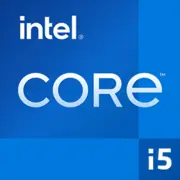Intel Core i5-7500

Intel Core i5-7500: A Moderate Classic for Basic Tasks in 2025
Architecture, Performance, and Relevance in Modern Reality
Key Features: What Does Kaby Lake Offer?
The Intel Core i5-7500 processor, released in 2017, belongs to the Kaby Lake generation (7th generation) and is still found in budget builds. Its key specifications are:
- 4 cores / 4 threads with no support for Hyper-Threading.
- Base frequency of 3.4 GHz, Turbo Boost up to 3.8 GHz.
- 14 nm process technology with a TDP of 65 W.
- Integrated graphics Intel HD Graphics 630.
- 6 MB of L3 cache and support for DDR4-2400 memory.
What Makes Kaby Lake Stand Out?
- Hardware video decoding for 4K (HEVC, VP9) — relevant for media centers.
- Improved energy efficiency compared to Skylake.
- Support for Optane Memory (for HDD acceleration).
Performance in 2025
According to Geekbench 6 tests:
- 1266 points (single-core) — on par with modern budget processors, such as Intel Celeron G6900 (~1300 points).
- 3462 points (multi-core) — weaker than even Ryzen 3 5300G (~4500 points).
For office tasks (Word, Excel, browsing) and streaming video, the processor can still manage, but it clearly shows its age in resource-intensive applications (video editing, 3D rendering).
Compatible Motherboards: Searching in Times of Scarcity
LGA 1151 Socket (v2 version) — a crucial factor. Only motherboards with 200-series chipsets are compatible:
- H110, B250, H270, Z270.
Selection Features in 2025:
- New motherboards are hardly produced. Only rare examples remain on the market, such as the ASUS Prime B250M-K (~$90-110).
- Z270 — an optimal choice for enthusiasts (memory overclocking support), but difficult to find new.
- H110 — a basic option, but may require a BIOS update for Kaby Lake support.
Tip: When buying a motherboard, check the compatibility list (QVL) on the manufacturer's website. For example, the Gigabyte H270-HD3 supports the i5-7500 "out of the box."
Memory Support: DDR4 as the Standard
The processor works only with DDR4-2133/2400 MHz.
- Maximum capacity: 64 GB (depends on the motherboard).
- Dual-channel mode is essential to unlock its potential.
Example Configuration:
2x8 GB DDR4-2400 (e.g., Kingston Fury) — optimal for gaming and multitasking.
Important: Attempting to install DDR5 (even through adapters) is pointless — the processor's memory controller does not support the new standard.
Power Supply: How Many Watts Are Needed?
With a TDP of 65 W, a system based on the i5-7500 does not require a powerful PSU:
- Without a discrete graphics card: 300-400 W (e.g., be quiet! Pure Power 11 400W).
- With a graphics card like the NVIDIA GTX 1660 Super: 500-550 W (Corsair CX550).
Calculation Example:
- i5-7500: 65 W.
- GTX 1660 Super: 125 W.
- Other components: ~50 W.
Total: 240 W under load. A 500 W PSU leaves headroom for stability.
Pros and Cons: Is It Worth Buying in 2025?
Pros:
- Low power consumption and heat generation.
- Sufficient for basic tasks and older games (CS:GO, Dota 2).
- Low price (~$80-100 for a new processor).
Cons:
- No support for Hyper-Threading — poor multi-threaded performance.
- Obsolete socket — no upgrade without replacing the motherboard.
- Incompatibility with PCIe 4.0/5.0 and DDR5.
Use Cases: Who Is It Relevant For?
1. Office PC: Working with documents, video calls, watching YouTube.
2. Home Media Center: Streaming 4K via Plex or Kodi.
3. Undemanding Gaming: Rocket League, Minecraft, GTA V (on medium settings with a GTX 1650 level graphics card).
4. Entry-Level Server: NAS or home file hosting.
Real Experience: A user from a dedicated forum built a budget PC for study using the i5-7500: 16 GB DDR4, 500 GB SSD, without a graphics card. The system manages Zoom, Google Classroom, and even light video editing in Shotcut.
Comparison with Competitors
1. AMD Ryzen 5 1400 (2017):
- 4 cores / 8 threads, unlocked multiplier.
- 30-40% faster in multi-threaded tasks.
- Price: ~$90 (new).
2. Intel Core i3-12100 (2022):
- 4 cores / 8 threads, single-threaded performance is 60% higher.
- Price: ~$120 (new).
Conclusion: The i5-7500 lags behind even budget newcomers from 2022-2024 but has price advantages in the second-hand market.
Assembly Tips
1. Motherboard: Look for B250/H270 boards with a warranty (e.g., ASRock B250M Pro4).
2. Cooling: The stock cooler is sufficient — even for summer heat.
3. SSD Is Essential: Kingston A400 480 GB (~$35) will reduce system "slowdowns."
4. Graphics Card: Avoid installing the RTX 3060 or similar — the processor will bottleneck.
5. Budget Option: i5-7500 + 16 GB DDR4 + GTX 1650 + 500 GB SSD = ~$250-300 (excluding case and PSU).
Conclusion: Who Will Benefit from the i5-7500 in 2025?
This processor is worth considering only in two scenarios:
1. Building the Cheapest Possible PC for office work, studies, or browsing.
2. Upgrading an Old Computer on LGA 1151 (e.g., from a Pentium G4560).
Alternative: If the budget allows for $150-200, it’s better to opt for a new combo of Intel i3-13100F + H610 motherboard — this will provide future-proofing and support for DDR5/PCIe 5.0.
The i5-7500 is an example of a "workhorse" slowly retiring but still useful in non-demanding scenarios.
Basic
CPU Specifications
Memory Specifications
GPU Specifications
Miscellaneous
Benchmarks
Compared to Other CPU
Share in social media
Or Link To Us
<a href="https://cputronic.com/cpu/intel-core-i5-7500" target="_blank">Intel Core i5-7500</a>